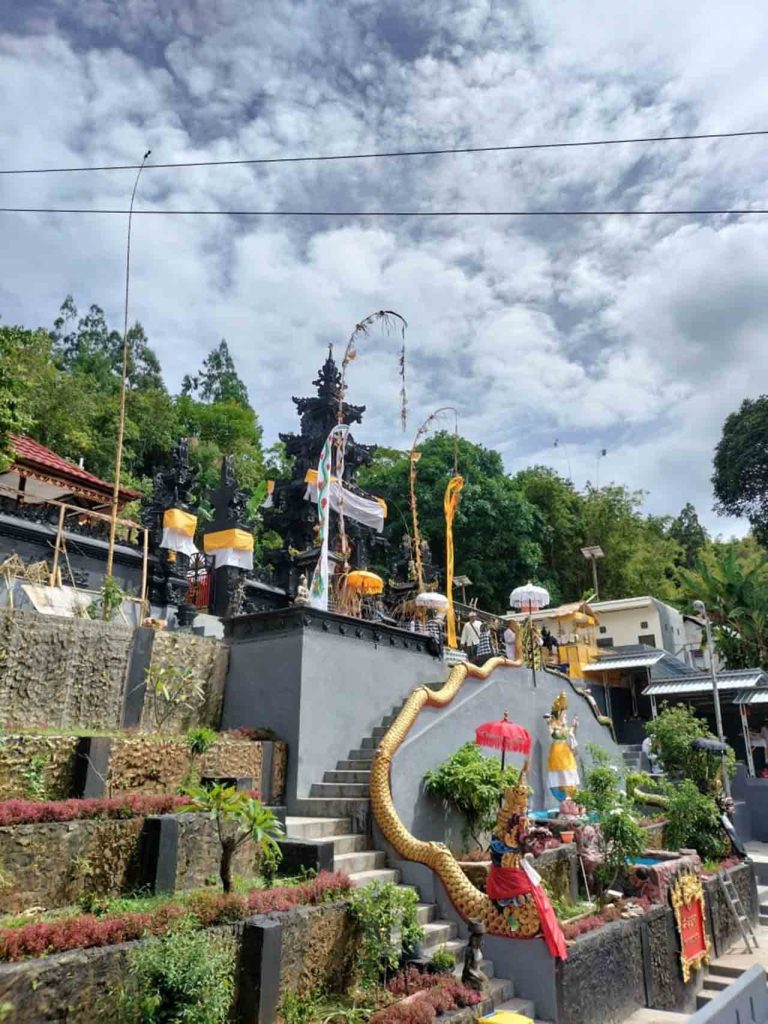Nestled in the heart of Denpasar City, Tambangan Badung Temple stands as one of Bali’s oldest and most historically significant places of worship. Located in Banjar Pemedilan Kerandan, Pemedilan Village, this sacred temple is easily accessible and lies just west of Pasah Pemedilan Market on Jalan Gunung Batur. Its central position and spiritual importance make it a vital part of the city’s religious and cultural identity.
Tambangan Badung Temple has a long and fascinating past that predates the reign of the first Anglurah of Pemecutan. It is one of the ancient temples of Bali, holding deep historical roots. The temple was later expanded and renovated under the direction of Bhatara Sakti, a king of the Badung Kingdom, and eventually came under the care of Puri Agung Pemecutan. Major renovations took place in 1928 and again in 1990, reflecting its continued importance to the local community.
Historical records, including the Babad Karana chronicle, mention that the temple was once called Pura Taman, before changing names to Pura Ayu Penestaran Panembahan Badung, and finally becoming known as Pura Tambangan Badung. These changes reflect its evolving role within the spiritual and royal structure of Badung.
Covering an area of approximately two hectares, the temple complex is divided into three main sections or mandalas. The outermost section, located directly in front of the market, features two cannons adorning the entrance gate, known locally as Gora and Gori. The middle section, or Madya Mandala, contains an open pavilion called a wantilan, used for gatherings and temple activities.
Passing through a unique gateway flanked by two statues—Jaksa and Jaksi—visitors enter the innermost area, the Utama Mandala. This is the most sacred and expansive part of the temple, filled with shrines and sacred structures, including the main shrine. Interestingly, the design and layout of the Utama Mandala resemble a royal palace, highlighting the temple’s deep connection to the Badung Kingdom.
What sets Tambangan Badung Temple apart is its dual entrances: Pemedalan Siwa Dalem Tambangan Badung to the east, and Pemedalan Ida Bhatari Durga to the west. Within the Utama Mandala, numerous shrines are arranged with precision and purpose. One particularly notable shrine is the Hyang Ibu Candi, shaped like a candi (temple tower), containing two linggas. Beneath this shrine are believed to lie ancient inscriptions detailing the temple’s history and its ties to the Balinese kingdom.
The principal shrine of the temple, known as Pelinggih Luhur Kaler or Anglayang, is dedicated to Ida Bhatara Siwa and is connected to Mount Agung, Batur, and Mount Jati. This shrine resembles a padmasana, adorned with mythical creatures such as Bedawang Nala and naga serpents. Adjacent to it is Gedong Dalem Tambangan Badung, the residence of Siwa Dalem and Ratu Ngurah Ratu Agung Kiwa Tengen.
Surrounding the main shrines are auxiliary shrines dedicated to various deities and spiritual figures, many of which represent aspects of the sacred Sad Kahyangan temples across Bali. These include representations of Sakenan, Uluwatu, Batukaru, Besakih, and Batur. Other shrines honor female spiritual figures, such as Hyang Ibu Agung, Ibu Jembrana, Ibu Taruna, and many others, reflecting a rich diversity of ancestral reverence.
The temple is also equipped with multiple ceremonial pavilions, including Bale Semanggen, Bale Prasanak, Bale Penganten Genah Bhatara Manik Galih, Bale Gajah, and Bale Pewaregan, among others. On the temple’s northern side lies a sacred area called Palebahan Pura, where Ratu Ayu Saren Taman is worshipped, along with deities like Ratu Mas Meketel, Bhatari Gayatri, and Bhatari Gangga.
Tambangan Badung Temple is also known for its unique ceremonial traditions. Among them is the Baris Tangklong dance, performed on the eve of Galungan, and the Siyat Sampian ritual on Manis Kuningan, symbolizing purification and the cultivation of a warrior spirit.
The temple’s major festival, or piodalan, is celebrated every 210 days, based on the Balinese Pawukon calendar, specifically on Wraspati Wuku Sungsang, coinciding with Sugian Jawa. Additionally, annual ceremonies take place during the full moon of the fourth month (Ngapat) and the tenth month (Kedase) in April.
Given its rich history, spiritual depth, and architectural grandeur, Tambangan Badung Temple holds a dual status—as both a Siwa temple and a royal temple—making it a central pillar of Bali’s religious heritage. (BT)





